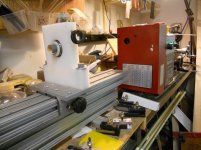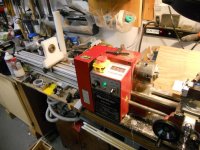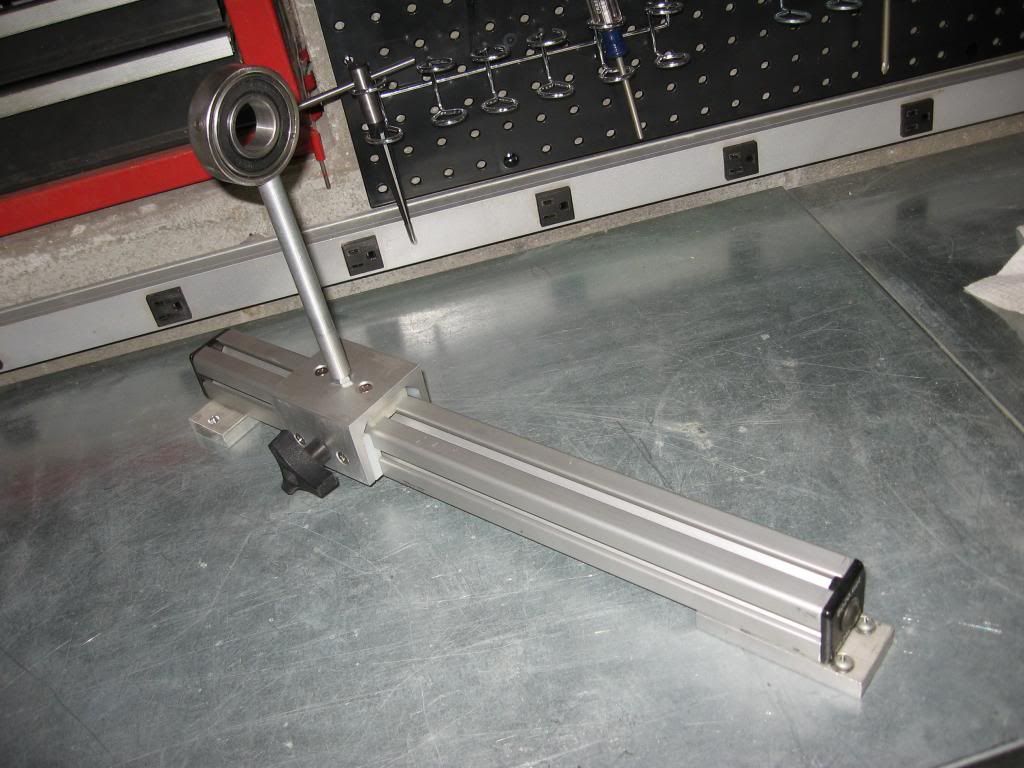I have had this little 7x10 harbor freight sitting around for a while and decided to go through it and clean it up and do some fine tuning. Is anyone here using one of these for anything cuemakeing related? Maybe set up for slicing rings or anything else? Just wondering if I should keep it around or maybe offload in on CL to invest the cash in something more useful to my new addiction. I sure would like to have a mini thickness sander and that would knock a chunk off the cost.
You are using an out of date browser. It may not display this or other websites correctly.
You should upgrade or use an alternative browser.
You should upgrade or use an alternative browser.
Any use for a Harbor Freight Mini Lathe?
- Thread starter Facundus Cues
- Start date
I have had this little 7x10 harbor freight sitting around for a while and decided to go through it and clean it up and do some fine tuning. Is anyone here using one of these for anything cuemakeing related? Maybe set up for slicing rings or anything else? Just wondering if I should keep it around or maybe offload in on CL to invest the cash in something more useful to my new addiction. I sure would like to have a mini thickness sander and that would knock a chunk off the cost.
Is it a mini metal lathe or a mini wood lathe? That will make a big difference. Mini metal lathe is always a good thing to keep, IMO. I have a more well built version of that lathe, 7x14 by Microlux, and I use mine mainly for tip and ferrule jobs, but also use it for making my ferrules, and collars and any other small machining process that I need.
Dave
It is a metal lathe.
Of course there's use for it
They will even thread
I had one
But the thru spindle hole might be just big enough for a shaft
Been a few yrs
I think mine was a Max rpm of 2000
They will even thread
I had one
But the thru spindle hole might be just big enough for a shaft
Been a few yrs
I think mine was a Max rpm of 2000
What state are you in ?
Where are you located ?
How does it weigh ?
I have had this little 7x10 harbor freight sitting around for a while and decided to go through it and clean it up and do some fine tuning. Is anyone here using one of these for anything cuemakeing related? Maybe set up for slicing rings or anything else? Just wondering if I should keep it around or maybe offload in on CL to invest the cash in something more useful to my new addiction. I sure would like to have a mini thickness sander and that would knock a chunk off the cost.
Where are you located ?
How does it weigh ?
Baton Rouge, LA - It is heavier than you would think. Probably 60-70 lbs
With a usable steady rest out back for the joint end of the shaft,and a little cleanup and tuning on the machine itself,you'd be real hard pressed to find a better tip and ferrule lathe.
With all the stuff you can do if it's capable of threading,trust me it makes it worth the effort to get it running right. Tommy D.
With all the stuff you can do if it's capable of threading,trust me it makes it worth the effort to get it running right. Tommy D.
Sounds like a keeper then. I originally bought it for tips and ferrules but never did much with it or made a steady rest for it. I was thinking that the threading could come in handy though. I do not have the change gears , guess I will have to go ebaying
Steady rest
You need to buy or make a steady rest for the back side of the spindle.
Maybe some one who has one can chime in with some photos.
Sounds like a keeper then. I originally bought it for tips and ferrules but never did much with it or made a steady rest for it. I was thinking that the threading could come in handy though. I do not have the change gears , guess I will have to go ebaying
You need to buy or make a steady rest for the back side of the spindle.
Maybe some one who has one can chime in with some photos.
I have seen some pics in the past of the ones with with a bearing mounted to either an adjustable pull out rod. Those looked pretty usable.
I have seen some pics in the past of the ones with with a bearing mounted to either an adjustable pull out rod. Those looked pretty usable.
If you have the counter space, you can also buy a 2nd bed (usually about $75) and install it behind and in line with the lathe and use the steady rest that came with your lathe on that bed to hold the joint end of the shaft.
If you have the counter space, you can also buy a 2nd bed (usually about $75) and install it behind and in line with the lathe and use the steady rest that came with your lathe on that bed to hold the joint end of the shaft.
Here is one that I made a few years ago. It's nothing more than a little alum. plate, some all-thread and a bearing. I have since bought a more slick looking one off of somebody on this forum. I use this for all tips and most ferrules. I have two of these One was made in 83 but has no automatic feed on it. I was using it for tournaments and play-offs. It got to be a pain in the arse taking it off the work bench that I had it mounted on so I bought a new one, put on a quick change toolpost, a lever tailstock lock down. I can do tips and ferrules, by removing the tailstock I can clean and polish shafts and steam dents and I have wrapped a couple of cues on it.

Dick
Lathes
Have you made anything with the lathe ?
I have seen some pics in the past of the ones with with a bearing mounted to either an adjustable pull out rod. Those looked pretty usable.
Have you made anything with the lathe ?
Here is my setup, which is adjustable, as most shafts have different tapers/thickness, so rather then make a dozen collets, I did this. I also can do bar cues with this setup.
Dave
View attachment 422313
View attachment 422314
The base 80/20 is the same as the one hat I use now however the bearing holder is much different.
Dick
That 80/20 and linear bearing is pretty slick compared to this contraption that my lathe came with,as it was set up for cue repair when I bought it used.
It's overbuilt for the purpose,but I don't have to change collets with it either.
I just let the shaft settle in where it wants,pull back on it until it snugs itself and adjust the position of the base in relation to the back of the lathe,where it's weight keeps it place. The only time I need to adjust the height of the bearing is when I take the lathe out of the shop to go do a tournament,and have to tweak it a little to compensate for it being on a different table than usual. The Delrin collet it came with can also be used in the steady rest for my Cuesmith lathe as well. This collet is only removed if I need it on the Cuesmith,or when I need to retip a one piece house cue.
The lathe itself is now bolted to 2 pieces of 12" long 1"x3" 80/20 using the holes drilled into the casting for the rubber feet,giving me a much wider footprint than stock,and still use the rubber feet under the 80/20. Tommy D.
It's overbuilt for the purpose,but I don't have to change collets with it either.
I just let the shaft settle in where it wants,pull back on it until it snugs itself and adjust the position of the base in relation to the back of the lathe,where it's weight keeps it place. The only time I need to adjust the height of the bearing is when I take the lathe out of the shop to go do a tournament,and have to tweak it a little to compensate for it being on a different table than usual. The Delrin collet it came with can also be used in the steady rest for my Cuesmith lathe as well. This collet is only removed if I need it on the Cuesmith,or when I need to retip a one piece house cue.
The lathe itself is now bolted to 2 pieces of 12" long 1"x3" 80/20 using the holes drilled into the casting for the rubber feet,giving me a much wider footprint than stock,and still use the rubber feet under the 80/20. Tommy D.
Attachments
This is the exact one that I have and I believe that you are the one that I purchased it from. Works very well and is much more professional looking than the one that I had made for myself.
Dick
Chuck should build some more of these.
Sent from my iPhone using Tapatalk
Sent from my iPhone using Tapatalk





